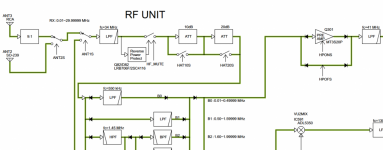To be honest I felt like pcrguy was yelling at me at me.
It made me wonder how a passive device could add to noise. Considering the whole concept of low noise amplifiers are large gain with minimal atomic noise.
Thinking back to the LNA's on c band tvro dishes from the 80's with separate detatched downconverters.
When gasfet's, etc. were hand picked and sorted for their low noise, kelvin temperature.
An interesting conversation with what seems to make valid points. All the math aside. Is linked here below.
Makes me think that a wideband antenna with overwhelming RF undesired frequencies (FM broadcast) would benefit from attenuation before the preamp section. Definitely notching the undesired would be beneficial. It seems to me.
In the IC-R8600 diagram ANT2S is the switched N Type connector for 30-3000 MHz antenna input. Pre filtering and pre attenuation.
But all before the switchable LNA.
I guess I'm more understanding of audio circuitry. But certainly enjoy RF also. In the case of CD, DVD, Digital input sources.
They output a 2 V peak to peak signal. And receivers with inputs for them are specified to accept the higher levels.
If you were to attach the same players to a tape in, aux. port. Sound levels are much higher and distortion is most likely going to happen in the preamplifier section. But inline attenuators designed for the purpose of knocking the level down certainly do not create noise.
The circuitry of them most probably being a voltage divider.
Where am I missing that a passive component attenuator could add to noise figures?
Why would you put an attenuator before an amplifier? - Page 1
www.eevblog.com


